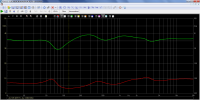Apologies for the amatuer question, but my woofer in my 3 way DIY speaker drops down to 3.3 ohms and I have two spare amps that I can BTL if it wasn't for the drop in ohms, I can use them as they have more power than my current amp. The woofer driver impedance graph from the manufacturer has it at around 8ohm but I know all that changes.
I dont want to touch the inductor as it is the low pass which is needed for the crossover to the mid woofer but the capacitor is not so important. Can the capacitor have any effect on the impedance or is the box volume more of a culprite?
Is there any way around this drop in ohms for the woofer?
I dont want to touch the inductor as it is the low pass which is needed for the crossover to the mid woofer but the capacitor is not so important. Can the capacitor have any effect on the impedance or is the box volume more of a culprite?
Is there any way around this drop in ohms for the woofer?


.jpg)